Audit and Assurance Services: Opportunities and Threats Report
VerifiedAdded on 2021/04/24
|15
|4195
|391
Report
AI Summary
This report provides a comprehensive analysis of audit and assurance services, focusing on the impact of technological innovation on traditional audit methodologies. It begins by examining the opportunities and threats presented by innovation, such as the enhanced data analytics capabilities and the challenges of maintaining professional standards. The report then delves into the auditor's ability to uphold ethical principles and maintain independent opinions in the face of these changes. It emphasizes the importance of independence of mind and appearance. Furthermore, the report assesses the capacity of regulators to keep pace with the rapid advancements in the audit profession, ensuring the maintenance of required audit standards. The report highlights the benefits of innovation, including improved data analysis and efficiency, while also addressing potential threats such as resource constraints and the need for auditors to adapt to new technologies. The discussion also covers how these innovations affect ethical considerations and the maintenance of independence in audit opinions. The report concludes by emphasizing the need for audit firms and regulators to adapt to the changing landscape of auditing to maintain audit quality.
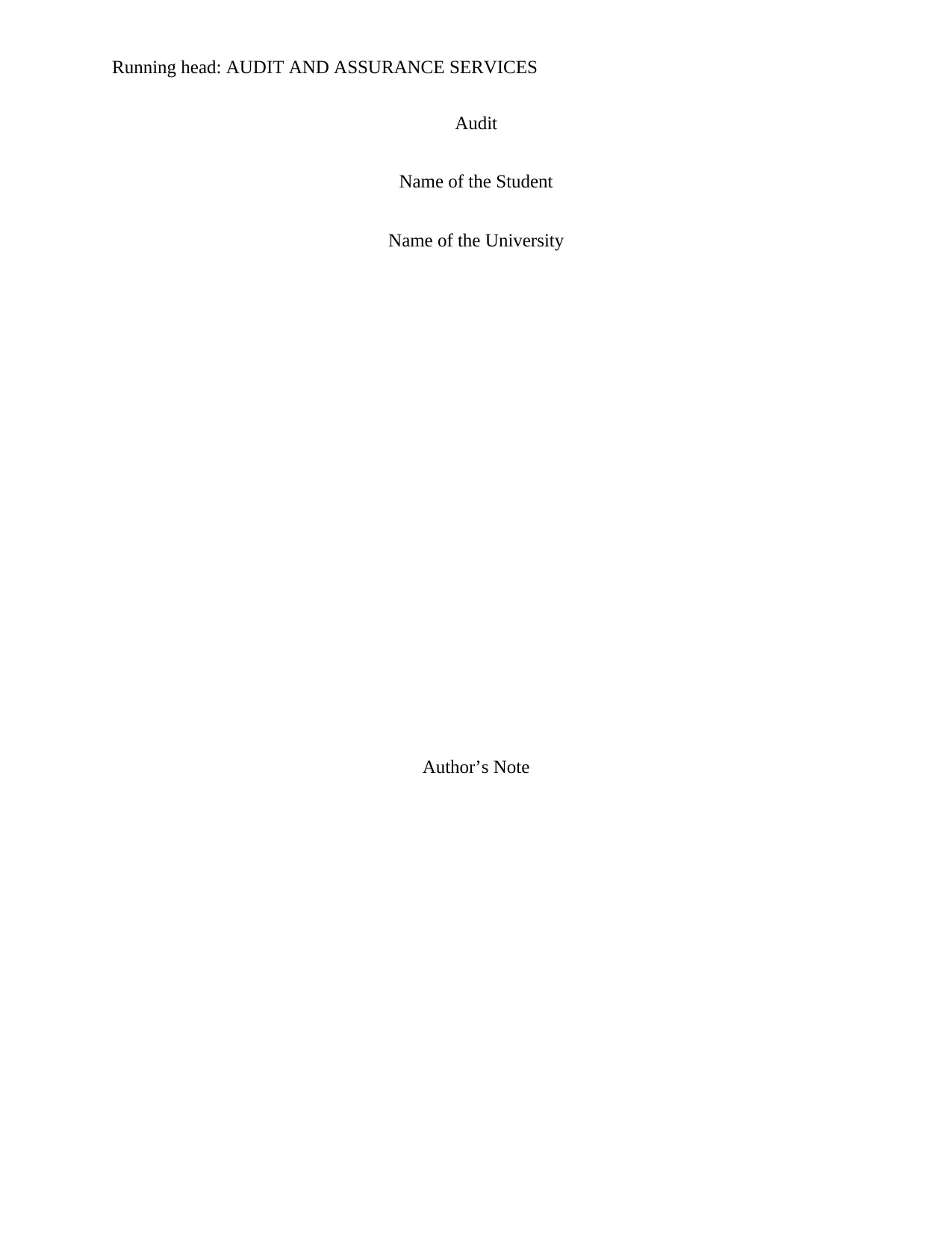
Running head: AUDIT AND ASSURANCE SERVICES
Audit
Name of the Student
Name of the University
Author’s Note
Audit
Name of the Student
Name of the University
Author’s Note
Paraphrase This Document
Need a fresh take? Get an instant paraphrase of this document with our AI Paraphraser
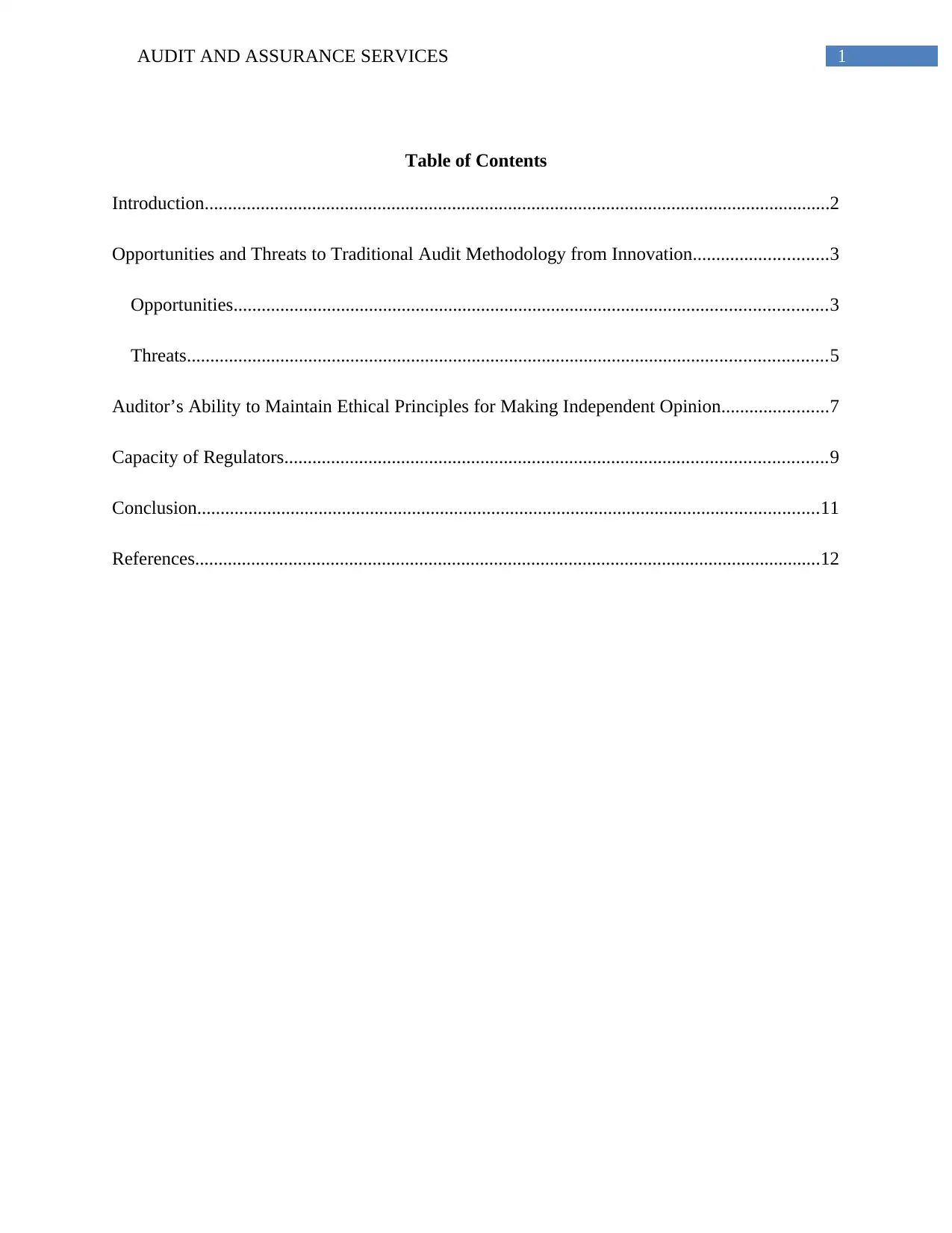
1AUDIT AND ASSURANCE SERVICES
Table of Contents
Introduction......................................................................................................................................2
Opportunities and Threats to Traditional Audit Methodology from Innovation.............................3
Opportunities...............................................................................................................................3
Threats.........................................................................................................................................5
Auditor’s Ability to Maintain Ethical Principles for Making Independent Opinion.......................7
Capacity of Regulators....................................................................................................................9
Conclusion.....................................................................................................................................11
References......................................................................................................................................12
Table of Contents
Introduction......................................................................................................................................2
Opportunities and Threats to Traditional Audit Methodology from Innovation.............................3
Opportunities...............................................................................................................................3
Threats.........................................................................................................................................5
Auditor’s Ability to Maintain Ethical Principles for Making Independent Opinion.......................7
Capacity of Regulators....................................................................................................................9
Conclusion.....................................................................................................................................11
References......................................................................................................................................12
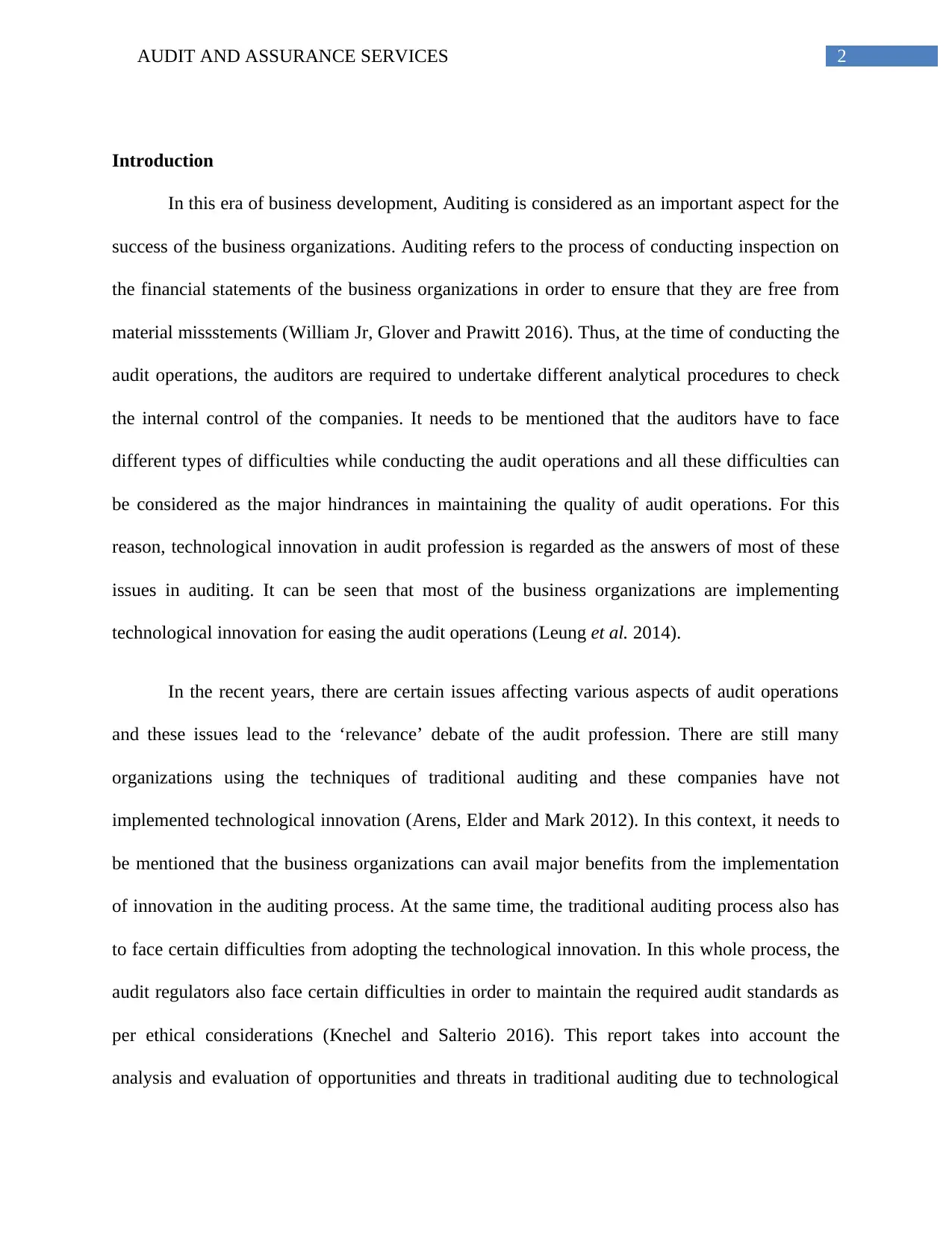
2AUDIT AND ASSURANCE SERVICES
Introduction
In this era of business development, Auditing is considered as an important aspect for the
success of the business organizations. Auditing refers to the process of conducting inspection on
the financial statements of the business organizations in order to ensure that they are free from
material missstements (William Jr, Glover and Prawitt 2016). Thus, at the time of conducting the
audit operations, the auditors are required to undertake different analytical procedures to check
the internal control of the companies. It needs to be mentioned that the auditors have to face
different types of difficulties while conducting the audit operations and all these difficulties can
be considered as the major hindrances in maintaining the quality of audit operations. For this
reason, technological innovation in audit profession is regarded as the answers of most of these
issues in auditing. It can be seen that most of the business organizations are implementing
technological innovation for easing the audit operations (Leung et al. 2014).
In the recent years, there are certain issues affecting various aspects of audit operations
and these issues lead to the ‘relevance’ debate of the audit profession. There are still many
organizations using the techniques of traditional auditing and these companies have not
implemented technological innovation (Arens, Elder and Mark 2012). In this context, it needs to
be mentioned that the business organizations can avail major benefits from the implementation
of innovation in the auditing process. At the same time, the traditional auditing process also has
to face certain difficulties from adopting the technological innovation. In this whole process, the
audit regulators also face certain difficulties in order to maintain the required audit standards as
per ethical considerations (Knechel and Salterio 2016). This report takes into account the
analysis and evaluation of opportunities and threats in traditional auditing due to technological
Introduction
In this era of business development, Auditing is considered as an important aspect for the
success of the business organizations. Auditing refers to the process of conducting inspection on
the financial statements of the business organizations in order to ensure that they are free from
material missstements (William Jr, Glover and Prawitt 2016). Thus, at the time of conducting the
audit operations, the auditors are required to undertake different analytical procedures to check
the internal control of the companies. It needs to be mentioned that the auditors have to face
different types of difficulties while conducting the audit operations and all these difficulties can
be considered as the major hindrances in maintaining the quality of audit operations. For this
reason, technological innovation in audit profession is regarded as the answers of most of these
issues in auditing. It can be seen that most of the business organizations are implementing
technological innovation for easing the audit operations (Leung et al. 2014).
In the recent years, there are certain issues affecting various aspects of audit operations
and these issues lead to the ‘relevance’ debate of the audit profession. There are still many
organizations using the techniques of traditional auditing and these companies have not
implemented technological innovation (Arens, Elder and Mark 2012). In this context, it needs to
be mentioned that the business organizations can avail major benefits from the implementation
of innovation in the auditing process. At the same time, the traditional auditing process also has
to face certain difficulties from adopting the technological innovation. In this whole process, the
audit regulators also face certain difficulties in order to maintain the required audit standards as
per ethical considerations (Knechel and Salterio 2016). This report takes into account the
analysis and evaluation of opportunities and threats in traditional auditing due to technological
⊘ This is a preview!⊘
Do you want full access?
Subscribe today to unlock all pages.

Trusted by 1+ million students worldwide
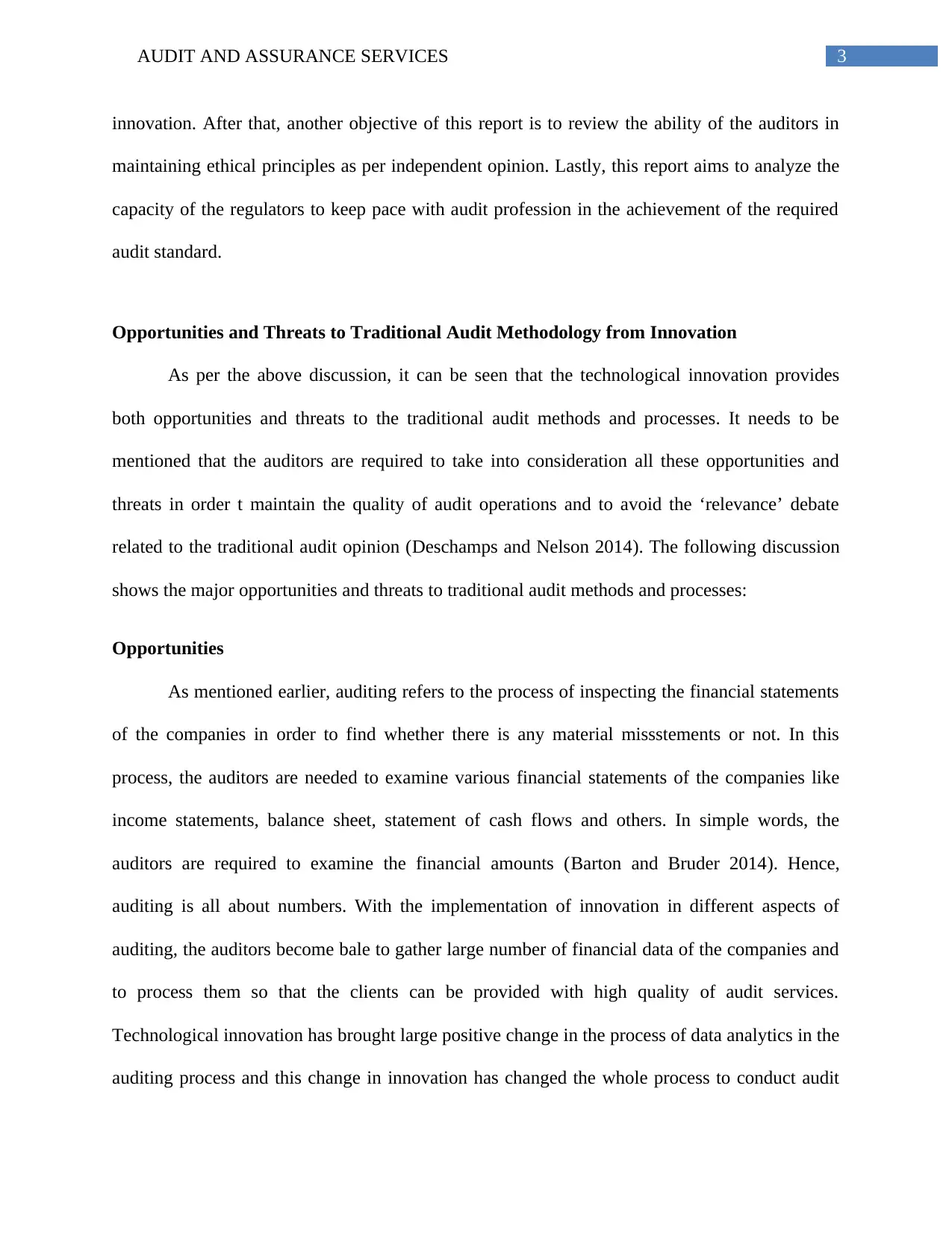
3AUDIT AND ASSURANCE SERVICES
innovation. After that, another objective of this report is to review the ability of the auditors in
maintaining ethical principles as per independent opinion. Lastly, this report aims to analyze the
capacity of the regulators to keep pace with audit profession in the achievement of the required
audit standard.
Opportunities and Threats to Traditional Audit Methodology from Innovation
As per the above discussion, it can be seen that the technological innovation provides
both opportunities and threats to the traditional audit methods and processes. It needs to be
mentioned that the auditors are required to take into consideration all these opportunities and
threats in order t maintain the quality of audit operations and to avoid the ‘relevance’ debate
related to the traditional audit opinion (Deschamps and Nelson 2014). The following discussion
shows the major opportunities and threats to traditional audit methods and processes:
Opportunities
As mentioned earlier, auditing refers to the process of inspecting the financial statements
of the companies in order to find whether there is any material missstements or not. In this
process, the auditors are needed to examine various financial statements of the companies like
income statements, balance sheet, statement of cash flows and others. In simple words, the
auditors are required to examine the financial amounts (Barton and Bruder 2014). Hence,
auditing is all about numbers. With the implementation of innovation in different aspects of
auditing, the auditors become bale to gather large number of financial data of the companies and
to process them so that the clients can be provided with high quality of audit services.
Technological innovation has brought large positive change in the process of data analytics in the
auditing process and this change in innovation has changed the whole process to conduct audit
innovation. After that, another objective of this report is to review the ability of the auditors in
maintaining ethical principles as per independent opinion. Lastly, this report aims to analyze the
capacity of the regulators to keep pace with audit profession in the achievement of the required
audit standard.
Opportunities and Threats to Traditional Audit Methodology from Innovation
As per the above discussion, it can be seen that the technological innovation provides
both opportunities and threats to the traditional audit methods and processes. It needs to be
mentioned that the auditors are required to take into consideration all these opportunities and
threats in order t maintain the quality of audit operations and to avoid the ‘relevance’ debate
related to the traditional audit opinion (Deschamps and Nelson 2014). The following discussion
shows the major opportunities and threats to traditional audit methods and processes:
Opportunities
As mentioned earlier, auditing refers to the process of inspecting the financial statements
of the companies in order to find whether there is any material missstements or not. In this
process, the auditors are needed to examine various financial statements of the companies like
income statements, balance sheet, statement of cash flows and others. In simple words, the
auditors are required to examine the financial amounts (Barton and Bruder 2014). Hence,
auditing is all about numbers. With the implementation of innovation in different aspects of
auditing, the auditors become bale to gather large number of financial data of the companies and
to process them so that the clients can be provided with high quality of audit services.
Technological innovation has brought large positive change in the process of data analytics in the
auditing process and this change in innovation has changed the whole process to conduct audit
Paraphrase This Document
Need a fresh take? Get an instant paraphrase of this document with our AI Paraphraser
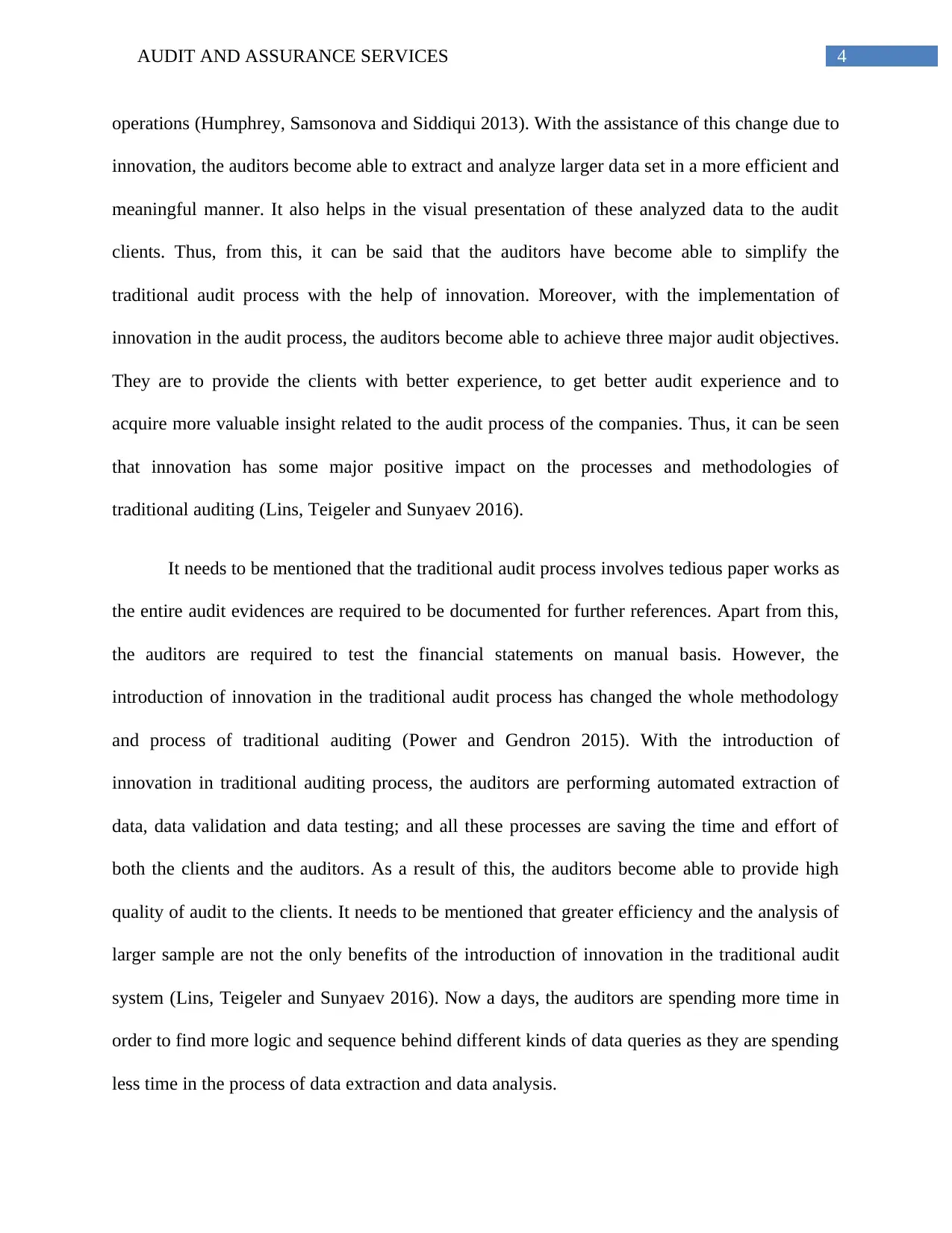
4AUDIT AND ASSURANCE SERVICES
operations (Humphrey, Samsonova and Siddiqui 2013). With the assistance of this change due to
innovation, the auditors become able to extract and analyze larger data set in a more efficient and
meaningful manner. It also helps in the visual presentation of these analyzed data to the audit
clients. Thus, from this, it can be said that the auditors have become able to simplify the
traditional audit process with the help of innovation. Moreover, with the implementation of
innovation in the audit process, the auditors become able to achieve three major audit objectives.
They are to provide the clients with better experience, to get better audit experience and to
acquire more valuable insight related to the audit process of the companies. Thus, it can be seen
that innovation has some major positive impact on the processes and methodologies of
traditional auditing (Lins, Teigeler and Sunyaev 2016).
It needs to be mentioned that the traditional audit process involves tedious paper works as
the entire audit evidences are required to be documented for further references. Apart from this,
the auditors are required to test the financial statements on manual basis. However, the
introduction of innovation in the traditional audit process has changed the whole methodology
and process of traditional auditing (Power and Gendron 2015). With the introduction of
innovation in traditional auditing process, the auditors are performing automated extraction of
data, data validation and data testing; and all these processes are saving the time and effort of
both the clients and the auditors. As a result of this, the auditors become able to provide high
quality of audit to the clients. It needs to be mentioned that greater efficiency and the analysis of
larger sample are not the only benefits of the introduction of innovation in the traditional audit
system (Lins, Teigeler and Sunyaev 2016). Now a days, the auditors are spending more time in
order to find more logic and sequence behind different kinds of data queries as they are spending
less time in the process of data extraction and data analysis.
operations (Humphrey, Samsonova and Siddiqui 2013). With the assistance of this change due to
innovation, the auditors become able to extract and analyze larger data set in a more efficient and
meaningful manner. It also helps in the visual presentation of these analyzed data to the audit
clients. Thus, from this, it can be said that the auditors have become able to simplify the
traditional audit process with the help of innovation. Moreover, with the implementation of
innovation in the audit process, the auditors become able to achieve three major audit objectives.
They are to provide the clients with better experience, to get better audit experience and to
acquire more valuable insight related to the audit process of the companies. Thus, it can be seen
that innovation has some major positive impact on the processes and methodologies of
traditional auditing (Lins, Teigeler and Sunyaev 2016).
It needs to be mentioned that the traditional audit process involves tedious paper works as
the entire audit evidences are required to be documented for further references. Apart from this,
the auditors are required to test the financial statements on manual basis. However, the
introduction of innovation in the traditional audit process has changed the whole methodology
and process of traditional auditing (Power and Gendron 2015). With the introduction of
innovation in traditional auditing process, the auditors are performing automated extraction of
data, data validation and data testing; and all these processes are saving the time and effort of
both the clients and the auditors. As a result of this, the auditors become able to provide high
quality of audit to the clients. It needs to be mentioned that greater efficiency and the analysis of
larger sample are not the only benefits of the introduction of innovation in the traditional audit
system (Lins, Teigeler and Sunyaev 2016). Now a days, the auditors are spending more time in
order to find more logic and sequence behind different kinds of data queries as they are spending
less time in the process of data extraction and data analysis.
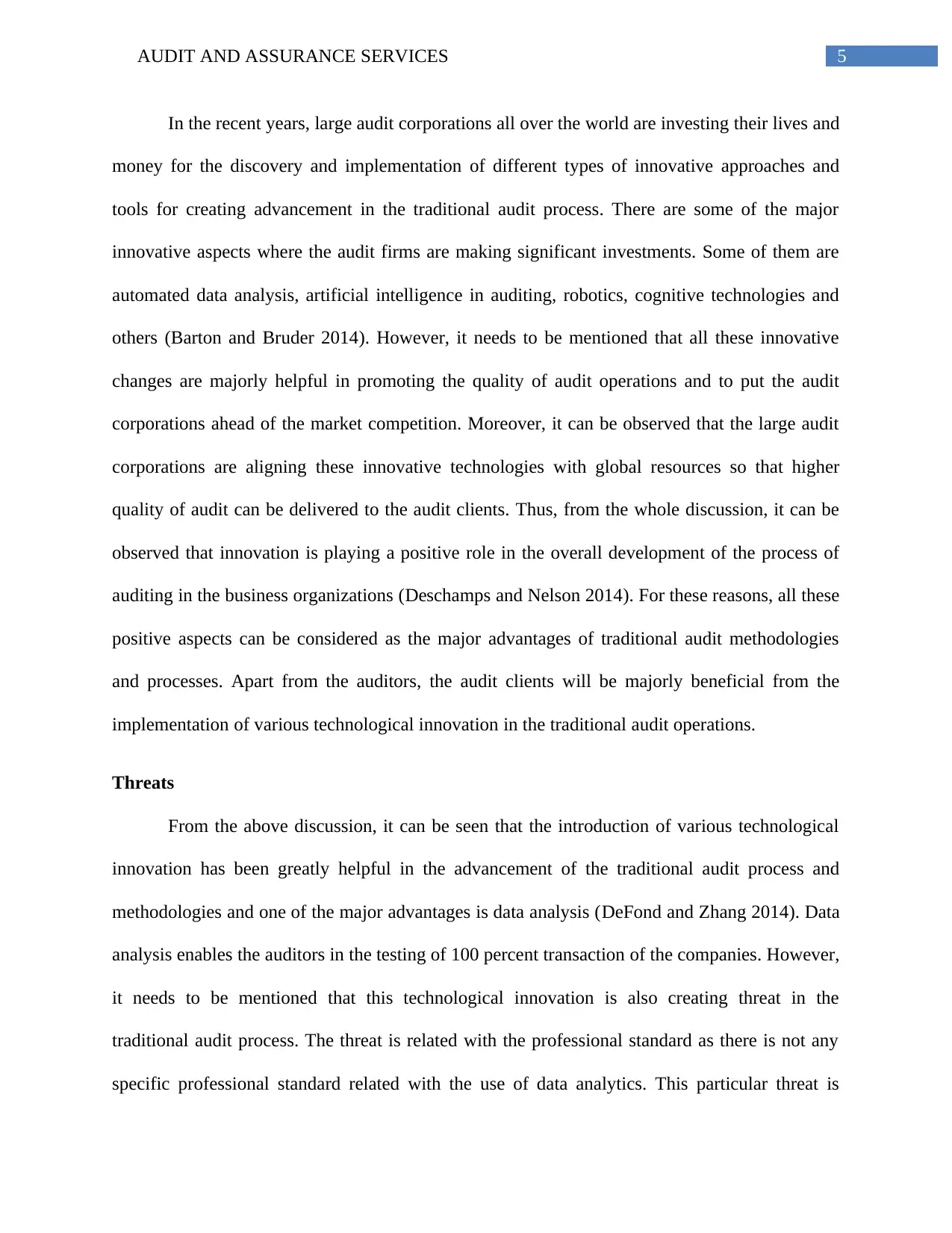
5AUDIT AND ASSURANCE SERVICES
In the recent years, large audit corporations all over the world are investing their lives and
money for the discovery and implementation of different types of innovative approaches and
tools for creating advancement in the traditional audit process. There are some of the major
innovative aspects where the audit firms are making significant investments. Some of them are
automated data analysis, artificial intelligence in auditing, robotics, cognitive technologies and
others (Barton and Bruder 2014). However, it needs to be mentioned that all these innovative
changes are majorly helpful in promoting the quality of audit operations and to put the audit
corporations ahead of the market competition. Moreover, it can be observed that the large audit
corporations are aligning these innovative technologies with global resources so that higher
quality of audit can be delivered to the audit clients. Thus, from the whole discussion, it can be
observed that innovation is playing a positive role in the overall development of the process of
auditing in the business organizations (Deschamps and Nelson 2014). For these reasons, all these
positive aspects can be considered as the major advantages of traditional audit methodologies
and processes. Apart from the auditors, the audit clients will be majorly beneficial from the
implementation of various technological innovation in the traditional audit operations.
Threats
From the above discussion, it can be seen that the introduction of various technological
innovation has been greatly helpful in the advancement of the traditional audit process and
methodologies and one of the major advantages is data analysis (DeFond and Zhang 2014). Data
analysis enables the auditors in the testing of 100 percent transaction of the companies. However,
it needs to be mentioned that this technological innovation is also creating threat in the
traditional audit process. The threat is related with the professional standard as there is not any
specific professional standard related with the use of data analytics. This particular threat is
In the recent years, large audit corporations all over the world are investing their lives and
money for the discovery and implementation of different types of innovative approaches and
tools for creating advancement in the traditional audit process. There are some of the major
innovative aspects where the audit firms are making significant investments. Some of them are
automated data analysis, artificial intelligence in auditing, robotics, cognitive technologies and
others (Barton and Bruder 2014). However, it needs to be mentioned that all these innovative
changes are majorly helpful in promoting the quality of audit operations and to put the audit
corporations ahead of the market competition. Moreover, it can be observed that the large audit
corporations are aligning these innovative technologies with global resources so that higher
quality of audit can be delivered to the audit clients. Thus, from the whole discussion, it can be
observed that innovation is playing a positive role in the overall development of the process of
auditing in the business organizations (Deschamps and Nelson 2014). For these reasons, all these
positive aspects can be considered as the major advantages of traditional audit methodologies
and processes. Apart from the auditors, the audit clients will be majorly beneficial from the
implementation of various technological innovation in the traditional audit operations.
Threats
From the above discussion, it can be seen that the introduction of various technological
innovation has been greatly helpful in the advancement of the traditional audit process and
methodologies and one of the major advantages is data analysis (DeFond and Zhang 2014). Data
analysis enables the auditors in the testing of 100 percent transaction of the companies. However,
it needs to be mentioned that this technological innovation is also creating threat in the
traditional audit process. The threat is related with the professional standard as there is not any
specific professional standard related with the use of data analytics. This particular threat is
⊘ This is a preview!⊘
Do you want full access?
Subscribe today to unlock all pages.

Trusted by 1+ million students worldwide
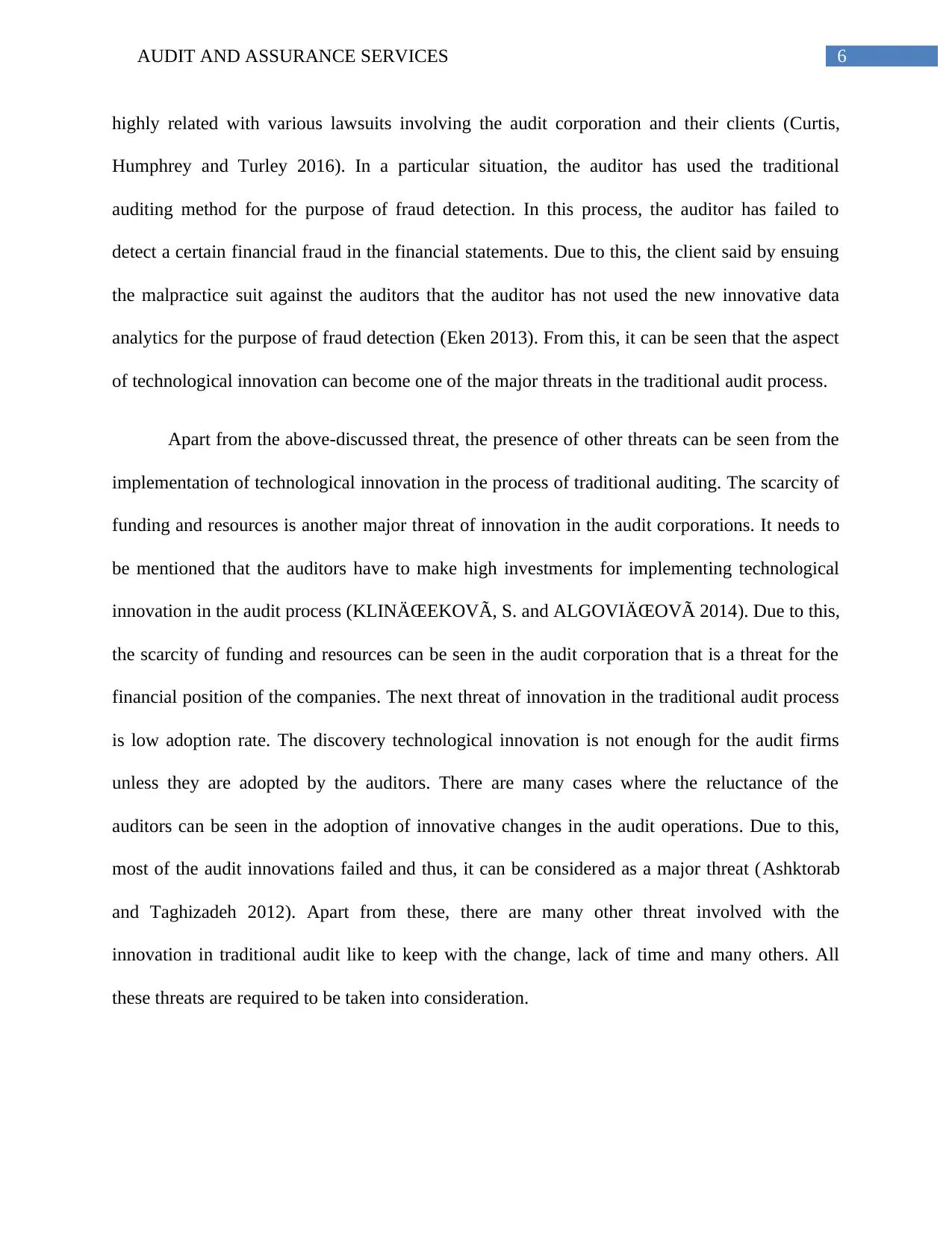
6AUDIT AND ASSURANCE SERVICES
highly related with various lawsuits involving the audit corporation and their clients (Curtis,
Humphrey and Turley 2016). In a particular situation, the auditor has used the traditional
auditing method for the purpose of fraud detection. In this process, the auditor has failed to
detect a certain financial fraud in the financial statements. Due to this, the client said by ensuing
the malpractice suit against the auditors that the auditor has not used the new innovative data
analytics for the purpose of fraud detection (Eken 2013). From this, it can be seen that the aspect
of technological innovation can become one of the major threats in the traditional audit process.
Apart from the above-discussed threat, the presence of other threats can be seen from the
implementation of technological innovation in the process of traditional auditing. The scarcity of
funding and resources is another major threat of innovation in the audit corporations. It needs to
be mentioned that the auditors have to make high investments for implementing technological
innovation in the audit process (KLINÄŒEKOVÃ, S. and ALGOVIÄŒOVÃ 2014). Due to this,
the scarcity of funding and resources can be seen in the audit corporation that is a threat for the
financial position of the companies. The next threat of innovation in the traditional audit process
is low adoption rate. The discovery technological innovation is not enough for the audit firms
unless they are adopted by the auditors. There are many cases where the reluctance of the
auditors can be seen in the adoption of innovative changes in the audit operations. Due to this,
most of the audit innovations failed and thus, it can be considered as a major threat (Ashktorab
and Taghizadeh 2012). Apart from these, there are many other threat involved with the
innovation in traditional audit like to keep with the change, lack of time and many others. All
these threats are required to be taken into consideration.
highly related with various lawsuits involving the audit corporation and their clients (Curtis,
Humphrey and Turley 2016). In a particular situation, the auditor has used the traditional
auditing method for the purpose of fraud detection. In this process, the auditor has failed to
detect a certain financial fraud in the financial statements. Due to this, the client said by ensuing
the malpractice suit against the auditors that the auditor has not used the new innovative data
analytics for the purpose of fraud detection (Eken 2013). From this, it can be seen that the aspect
of technological innovation can become one of the major threats in the traditional audit process.
Apart from the above-discussed threat, the presence of other threats can be seen from the
implementation of technological innovation in the process of traditional auditing. The scarcity of
funding and resources is another major threat of innovation in the audit corporations. It needs to
be mentioned that the auditors have to make high investments for implementing technological
innovation in the audit process (KLINÄŒEKOVÃ, S. and ALGOVIÄŒOVÃ 2014). Due to this,
the scarcity of funding and resources can be seen in the audit corporation that is a threat for the
financial position of the companies. The next threat of innovation in the traditional audit process
is low adoption rate. The discovery technological innovation is not enough for the audit firms
unless they are adopted by the auditors. There are many cases where the reluctance of the
auditors can be seen in the adoption of innovative changes in the audit operations. Due to this,
most of the audit innovations failed and thus, it can be considered as a major threat (Ashktorab
and Taghizadeh 2012). Apart from these, there are many other threat involved with the
innovation in traditional audit like to keep with the change, lack of time and many others. All
these threats are required to be taken into consideration.
Paraphrase This Document
Need a fresh take? Get an instant paraphrase of this document with our AI Paraphraser
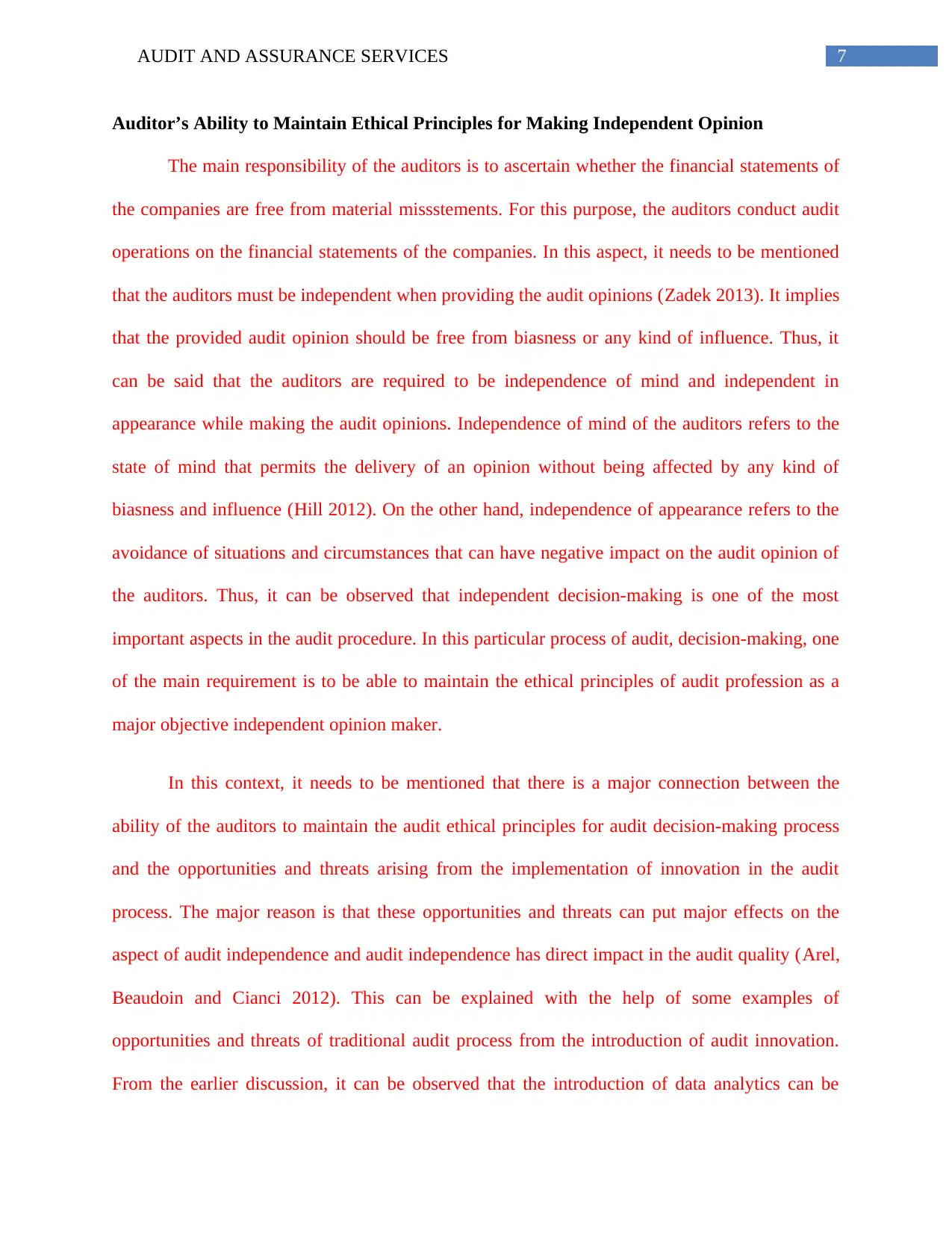
7AUDIT AND ASSURANCE SERVICES
Auditor’s Ability to Maintain Ethical Principles for Making Independent Opinion
The main responsibility of the auditors is to ascertain whether the financial statements of
the companies are free from material missstements. For this purpose, the auditors conduct audit
operations on the financial statements of the companies. In this aspect, it needs to be mentioned
that the auditors must be independent when providing the audit opinions (Zadek 2013). It implies
that the provided audit opinion should be free from biasness or any kind of influence. Thus, it
can be said that the auditors are required to be independence of mind and independent in
appearance while making the audit opinions. Independence of mind of the auditors refers to the
state of mind that permits the delivery of an opinion without being affected by any kind of
biasness and influence (Hill 2012). On the other hand, independence of appearance refers to the
avoidance of situations and circumstances that can have negative impact on the audit opinion of
the auditors. Thus, it can be observed that independent decision-making is one of the most
important aspects in the audit procedure. In this particular process of audit, decision-making, one
of the main requirement is to be able to maintain the ethical principles of audit profession as a
major objective independent opinion maker.
In this context, it needs to be mentioned that there is a major connection between the
ability of the auditors to maintain the audit ethical principles for audit decision-making process
and the opportunities and threats arising from the implementation of innovation in the audit
process. The major reason is that these opportunities and threats can put major effects on the
aspect of audit independence and audit independence has direct impact in the audit quality (Arel,
Beaudoin and Cianci 2012). This can be explained with the help of some examples of
opportunities and threats of traditional audit process from the introduction of audit innovation.
From the earlier discussion, it can be observed that the introduction of data analytics can be
Auditor’s Ability to Maintain Ethical Principles for Making Independent Opinion
The main responsibility of the auditors is to ascertain whether the financial statements of
the companies are free from material missstements. For this purpose, the auditors conduct audit
operations on the financial statements of the companies. In this aspect, it needs to be mentioned
that the auditors must be independent when providing the audit opinions (Zadek 2013). It implies
that the provided audit opinion should be free from biasness or any kind of influence. Thus, it
can be said that the auditors are required to be independence of mind and independent in
appearance while making the audit opinions. Independence of mind of the auditors refers to the
state of mind that permits the delivery of an opinion without being affected by any kind of
biasness and influence (Hill 2012). On the other hand, independence of appearance refers to the
avoidance of situations and circumstances that can have negative impact on the audit opinion of
the auditors. Thus, it can be observed that independent decision-making is one of the most
important aspects in the audit procedure. In this particular process of audit, decision-making, one
of the main requirement is to be able to maintain the ethical principles of audit profession as a
major objective independent opinion maker.
In this context, it needs to be mentioned that there is a major connection between the
ability of the auditors to maintain the audit ethical principles for audit decision-making process
and the opportunities and threats arising from the implementation of innovation in the audit
process. The major reason is that these opportunities and threats can put major effects on the
aspect of audit independence and audit independence has direct impact in the audit quality (Arel,
Beaudoin and Cianci 2012). This can be explained with the help of some examples of
opportunities and threats of traditional audit process from the introduction of audit innovation.
From the earlier discussion, it can be observed that the introduction of data analytics can be
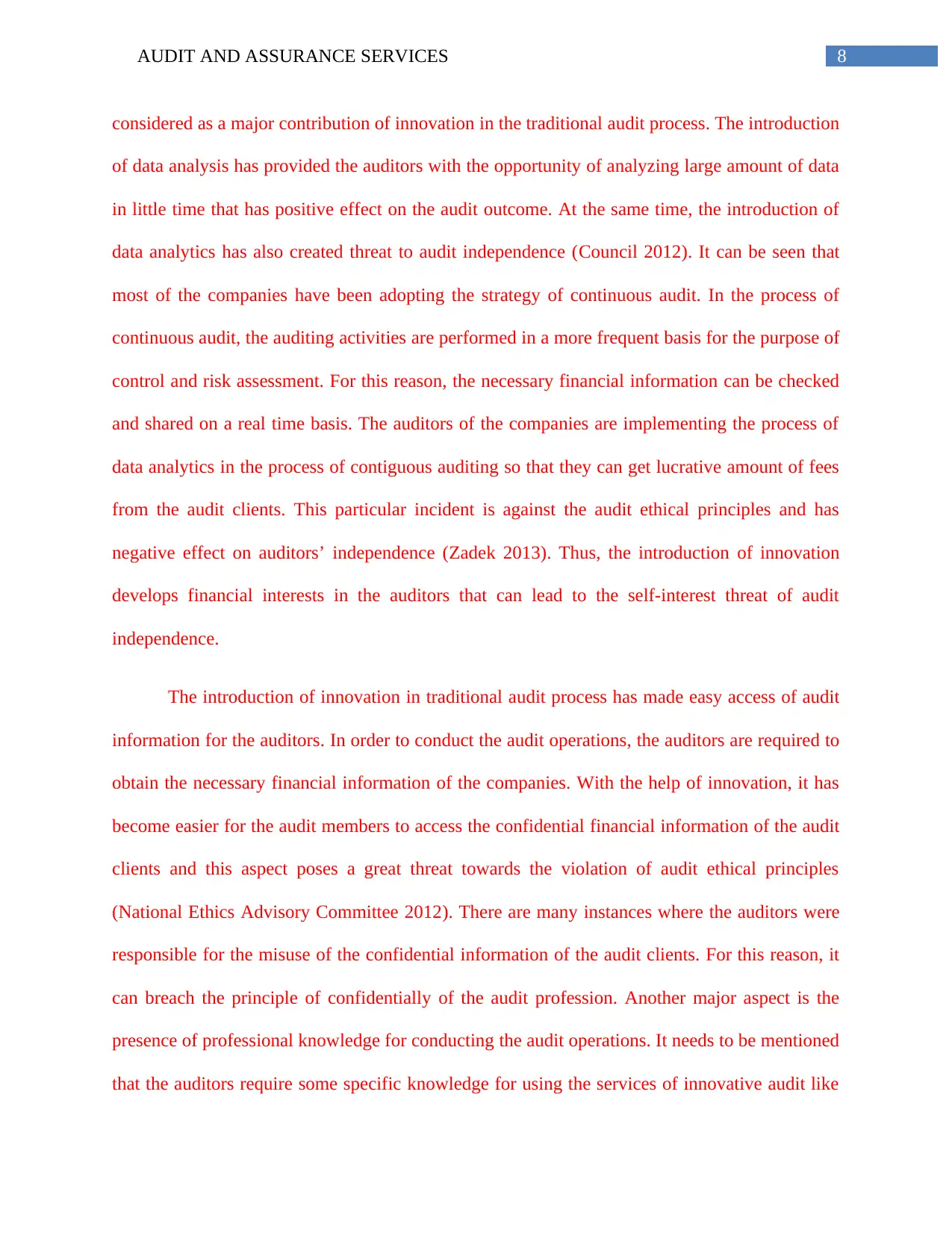
8AUDIT AND ASSURANCE SERVICES
considered as a major contribution of innovation in the traditional audit process. The introduction
of data analysis has provided the auditors with the opportunity of analyzing large amount of data
in little time that has positive effect on the audit outcome. At the same time, the introduction of
data analytics has also created threat to audit independence (Council 2012). It can be seen that
most of the companies have been adopting the strategy of continuous audit. In the process of
continuous audit, the auditing activities are performed in a more frequent basis for the purpose of
control and risk assessment. For this reason, the necessary financial information can be checked
and shared on a real time basis. The auditors of the companies are implementing the process of
data analytics in the process of contiguous auditing so that they can get lucrative amount of fees
from the audit clients. This particular incident is against the audit ethical principles and has
negative effect on auditors’ independence (Zadek 2013). Thus, the introduction of innovation
develops financial interests in the auditors that can lead to the self-interest threat of audit
independence.
The introduction of innovation in traditional audit process has made easy access of audit
information for the auditors. In order to conduct the audit operations, the auditors are required to
obtain the necessary financial information of the companies. With the help of innovation, it has
become easier for the audit members to access the confidential financial information of the audit
clients and this aspect poses a great threat towards the violation of audit ethical principles
(National Ethics Advisory Committee 2012). There are many instances where the auditors were
responsible for the misuse of the confidential information of the audit clients. For this reason, it
can breach the principle of confidentially of the audit profession. Another major aspect is the
presence of professional knowledge for conducting the audit operations. It needs to be mentioned
that the auditors require some specific knowledge for using the services of innovative audit like
considered as a major contribution of innovation in the traditional audit process. The introduction
of data analysis has provided the auditors with the opportunity of analyzing large amount of data
in little time that has positive effect on the audit outcome. At the same time, the introduction of
data analytics has also created threat to audit independence (Council 2012). It can be seen that
most of the companies have been adopting the strategy of continuous audit. In the process of
continuous audit, the auditing activities are performed in a more frequent basis for the purpose of
control and risk assessment. For this reason, the necessary financial information can be checked
and shared on a real time basis. The auditors of the companies are implementing the process of
data analytics in the process of contiguous auditing so that they can get lucrative amount of fees
from the audit clients. This particular incident is against the audit ethical principles and has
negative effect on auditors’ independence (Zadek 2013). Thus, the introduction of innovation
develops financial interests in the auditors that can lead to the self-interest threat of audit
independence.
The introduction of innovation in traditional audit process has made easy access of audit
information for the auditors. In order to conduct the audit operations, the auditors are required to
obtain the necessary financial information of the companies. With the help of innovation, it has
become easier for the audit members to access the confidential financial information of the audit
clients and this aspect poses a great threat towards the violation of audit ethical principles
(National Ethics Advisory Committee 2012). There are many instances where the auditors were
responsible for the misuse of the confidential information of the audit clients. For this reason, it
can breach the principle of confidentially of the audit profession. Another major aspect is the
presence of professional knowledge for conducting the audit operations. It needs to be mentioned
that the auditors require some specific knowledge for using the services of innovative audit like
⊘ This is a preview!⊘
Do you want full access?
Subscribe today to unlock all pages.

Trusted by 1+ million students worldwide
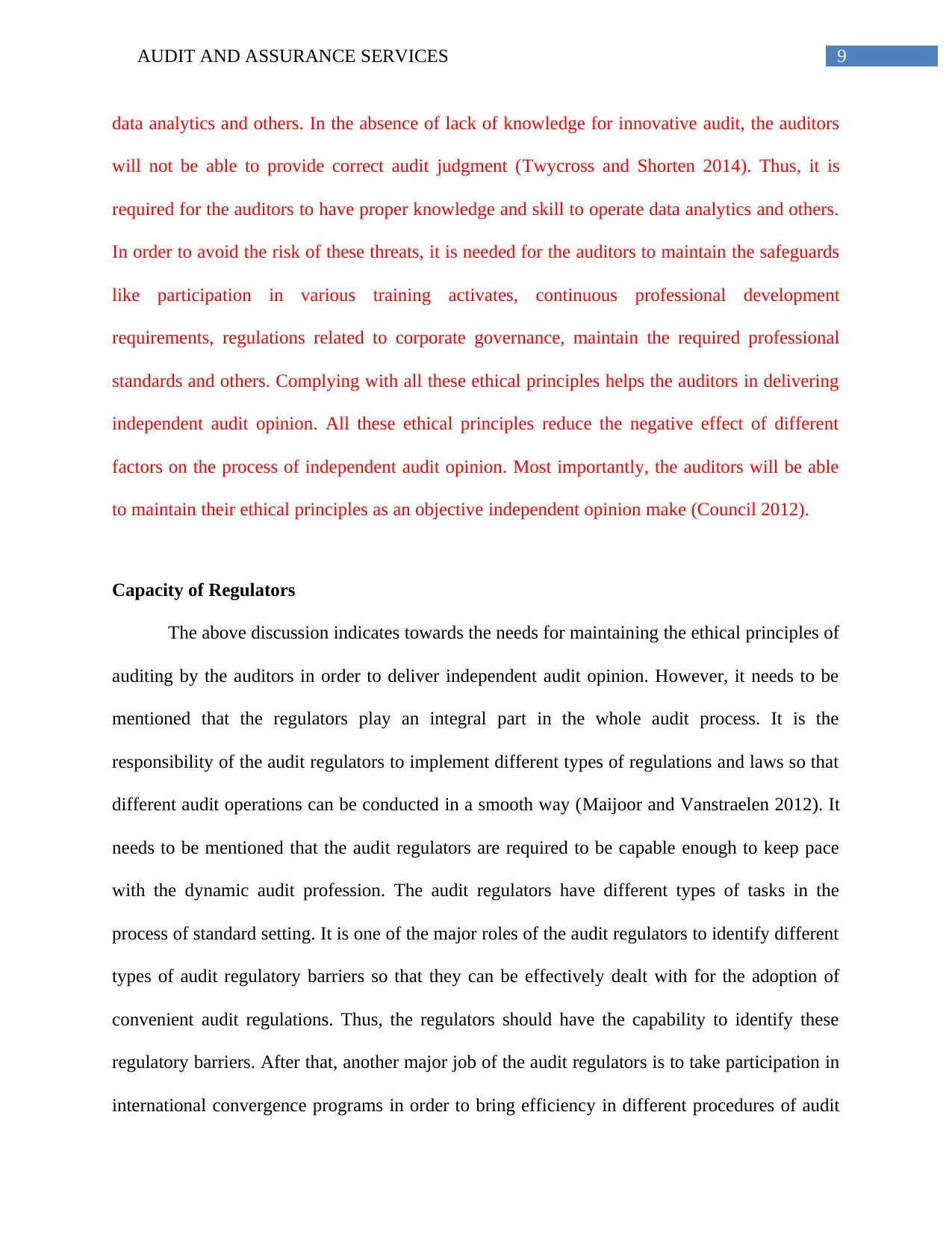
9AUDIT AND ASSURANCE SERVICES
data analytics and others. In the absence of lack of knowledge for innovative audit, the auditors
will not be able to provide correct audit judgment (Twycross and Shorten 2014). Thus, it is
required for the auditors to have proper knowledge and skill to operate data analytics and others.
In order to avoid the risk of these threats, it is needed for the auditors to maintain the safeguards
like participation in various training activates, continuous professional development
requirements, regulations related to corporate governance, maintain the required professional
standards and others. Complying with all these ethical principles helps the auditors in delivering
independent audit opinion. All these ethical principles reduce the negative effect of different
factors on the process of independent audit opinion. Most importantly, the auditors will be able
to maintain their ethical principles as an objective independent opinion make (Council 2012).
Capacity of Regulators
The above discussion indicates towards the needs for maintaining the ethical principles of
auditing by the auditors in order to deliver independent audit opinion. However, it needs to be
mentioned that the regulators play an integral part in the whole audit process. It is the
responsibility of the audit regulators to implement different types of regulations and laws so that
different audit operations can be conducted in a smooth way (Maijoor and Vanstraelen 2012). It
needs to be mentioned that the audit regulators are required to be capable enough to keep pace
with the dynamic audit profession. The audit regulators have different types of tasks in the
process of standard setting. It is one of the major roles of the audit regulators to identify different
types of audit regulatory barriers so that they can be effectively dealt with for the adoption of
convenient audit regulations. Thus, the regulators should have the capability to identify these
regulatory barriers. After that, another major job of the audit regulators is to take participation in
international convergence programs in order to bring efficiency in different procedures of audit
data analytics and others. In the absence of lack of knowledge for innovative audit, the auditors
will not be able to provide correct audit judgment (Twycross and Shorten 2014). Thus, it is
required for the auditors to have proper knowledge and skill to operate data analytics and others.
In order to avoid the risk of these threats, it is needed for the auditors to maintain the safeguards
like participation in various training activates, continuous professional development
requirements, regulations related to corporate governance, maintain the required professional
standards and others. Complying with all these ethical principles helps the auditors in delivering
independent audit opinion. All these ethical principles reduce the negative effect of different
factors on the process of independent audit opinion. Most importantly, the auditors will be able
to maintain their ethical principles as an objective independent opinion make (Council 2012).
Capacity of Regulators
The above discussion indicates towards the needs for maintaining the ethical principles of
auditing by the auditors in order to deliver independent audit opinion. However, it needs to be
mentioned that the regulators play an integral part in the whole audit process. It is the
responsibility of the audit regulators to implement different types of regulations and laws so that
different audit operations can be conducted in a smooth way (Maijoor and Vanstraelen 2012). It
needs to be mentioned that the audit regulators are required to be capable enough to keep pace
with the dynamic audit profession. The audit regulators have different types of tasks in the
process of standard setting. It is one of the major roles of the audit regulators to identify different
types of audit regulatory barriers so that they can be effectively dealt with for the adoption of
convenient audit regulations. Thus, the regulators should have the capability to identify these
regulatory barriers. After that, another major job of the audit regulators is to take participation in
international convergence programs in order to bring efficiency in different procedures of audit
Paraphrase This Document
Need a fresh take? Get an instant paraphrase of this document with our AI Paraphraser
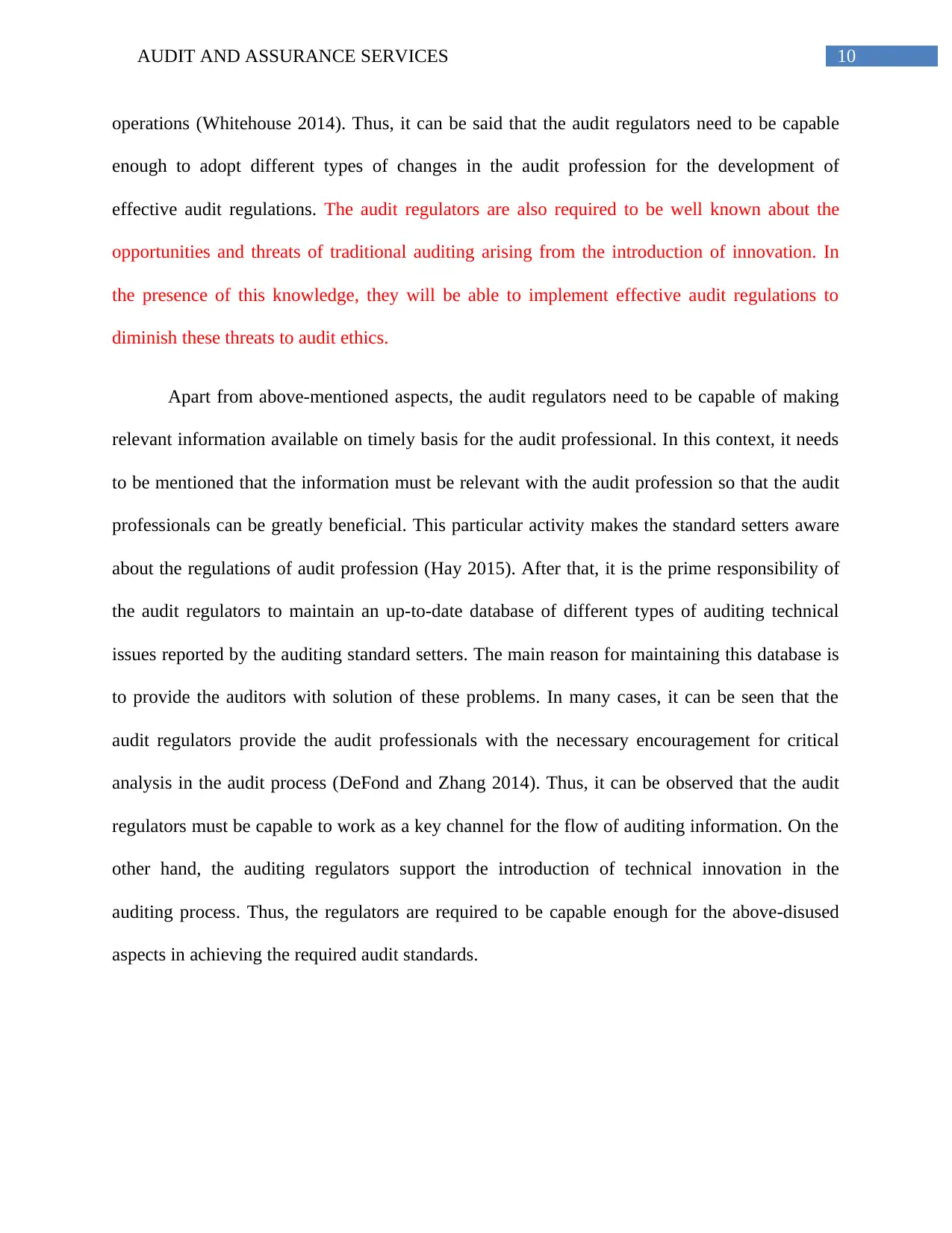
10AUDIT AND ASSURANCE SERVICES
operations (Whitehouse 2014). Thus, it can be said that the audit regulators need to be capable
enough to adopt different types of changes in the audit profession for the development of
effective audit regulations. The audit regulators are also required to be well known about the
opportunities and threats of traditional auditing arising from the introduction of innovation. In
the presence of this knowledge, they will be able to implement effective audit regulations to
diminish these threats to audit ethics.
Apart from above-mentioned aspects, the audit regulators need to be capable of making
relevant information available on timely basis for the audit professional. In this context, it needs
to be mentioned that the information must be relevant with the audit profession so that the audit
professionals can be greatly beneficial. This particular activity makes the standard setters aware
about the regulations of audit profession (Hay 2015). After that, it is the prime responsibility of
the audit regulators to maintain an up-to-date database of different types of auditing technical
issues reported by the auditing standard setters. The main reason for maintaining this database is
to provide the auditors with solution of these problems. In many cases, it can be seen that the
audit regulators provide the audit professionals with the necessary encouragement for critical
analysis in the audit process (DeFond and Zhang 2014). Thus, it can be observed that the audit
regulators must be capable to work as a key channel for the flow of auditing information. On the
other hand, the auditing regulators support the introduction of technical innovation in the
auditing process. Thus, the regulators are required to be capable enough for the above-disused
aspects in achieving the required audit standards.
operations (Whitehouse 2014). Thus, it can be said that the audit regulators need to be capable
enough to adopt different types of changes in the audit profession for the development of
effective audit regulations. The audit regulators are also required to be well known about the
opportunities and threats of traditional auditing arising from the introduction of innovation. In
the presence of this knowledge, they will be able to implement effective audit regulations to
diminish these threats to audit ethics.
Apart from above-mentioned aspects, the audit regulators need to be capable of making
relevant information available on timely basis for the audit professional. In this context, it needs
to be mentioned that the information must be relevant with the audit profession so that the audit
professionals can be greatly beneficial. This particular activity makes the standard setters aware
about the regulations of audit profession (Hay 2015). After that, it is the prime responsibility of
the audit regulators to maintain an up-to-date database of different types of auditing technical
issues reported by the auditing standard setters. The main reason for maintaining this database is
to provide the auditors with solution of these problems. In many cases, it can be seen that the
audit regulators provide the audit professionals with the necessary encouragement for critical
analysis in the audit process (DeFond and Zhang 2014). Thus, it can be observed that the audit
regulators must be capable to work as a key channel for the flow of auditing information. On the
other hand, the auditing regulators support the introduction of technical innovation in the
auditing process. Thus, the regulators are required to be capable enough for the above-disused
aspects in achieving the required audit standards.
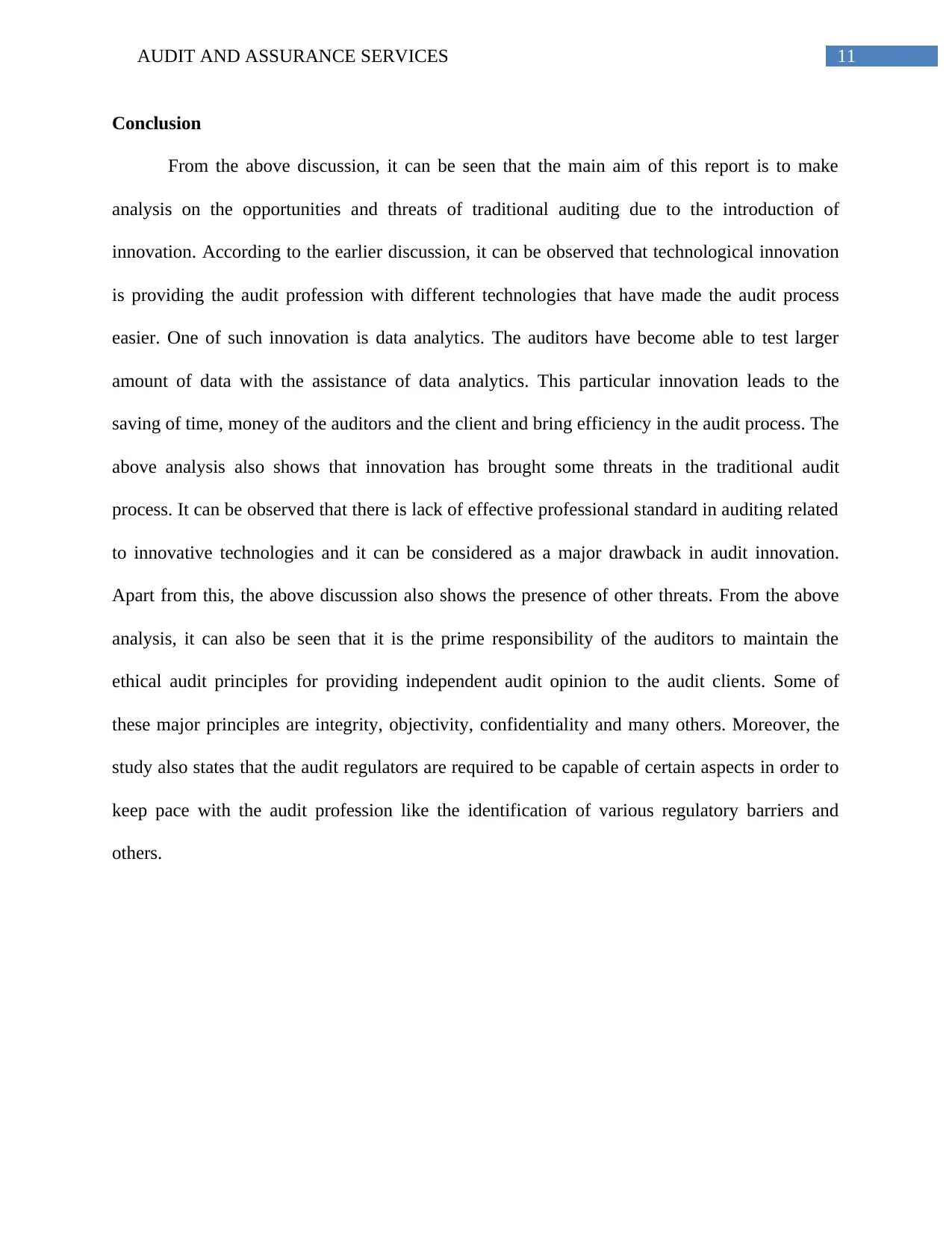
11AUDIT AND ASSURANCE SERVICES
Conclusion
From the above discussion, it can be seen that the main aim of this report is to make
analysis on the opportunities and threats of traditional auditing due to the introduction of
innovation. According to the earlier discussion, it can be observed that technological innovation
is providing the audit profession with different technologies that have made the audit process
easier. One of such innovation is data analytics. The auditors have become able to test larger
amount of data with the assistance of data analytics. This particular innovation leads to the
saving of time, money of the auditors and the client and bring efficiency in the audit process. The
above analysis also shows that innovation has brought some threats in the traditional audit
process. It can be observed that there is lack of effective professional standard in auditing related
to innovative technologies and it can be considered as a major drawback in audit innovation.
Apart from this, the above discussion also shows the presence of other threats. From the above
analysis, it can also be seen that it is the prime responsibility of the auditors to maintain the
ethical audit principles for providing independent audit opinion to the audit clients. Some of
these major principles are integrity, objectivity, confidentiality and many others. Moreover, the
study also states that the audit regulators are required to be capable of certain aspects in order to
keep pace with the audit profession like the identification of various regulatory barriers and
others.
Conclusion
From the above discussion, it can be seen that the main aim of this report is to make
analysis on the opportunities and threats of traditional auditing due to the introduction of
innovation. According to the earlier discussion, it can be observed that technological innovation
is providing the audit profession with different technologies that have made the audit process
easier. One of such innovation is data analytics. The auditors have become able to test larger
amount of data with the assistance of data analytics. This particular innovation leads to the
saving of time, money of the auditors and the client and bring efficiency in the audit process. The
above analysis also shows that innovation has brought some threats in the traditional audit
process. It can be observed that there is lack of effective professional standard in auditing related
to innovative technologies and it can be considered as a major drawback in audit innovation.
Apart from this, the above discussion also shows the presence of other threats. From the above
analysis, it can also be seen that it is the prime responsibility of the auditors to maintain the
ethical audit principles for providing independent audit opinion to the audit clients. Some of
these major principles are integrity, objectivity, confidentiality and many others. Moreover, the
study also states that the audit regulators are required to be capable of certain aspects in order to
keep pace with the audit profession like the identification of various regulatory barriers and
others.
⊘ This is a preview!⊘
Do you want full access?
Subscribe today to unlock all pages.

Trusted by 1+ million students worldwide
1 out of 15
Related Documents
Your All-in-One AI-Powered Toolkit for Academic Success.
+13062052269
info@desklib.com
Available 24*7 on WhatsApp / Email
![[object Object]](/_next/static/media/star-bottom.7253800d.svg)
Unlock your academic potential
Copyright © 2020–2025 A2Z Services. All Rights Reserved. Developed and managed by ZUCOL.





